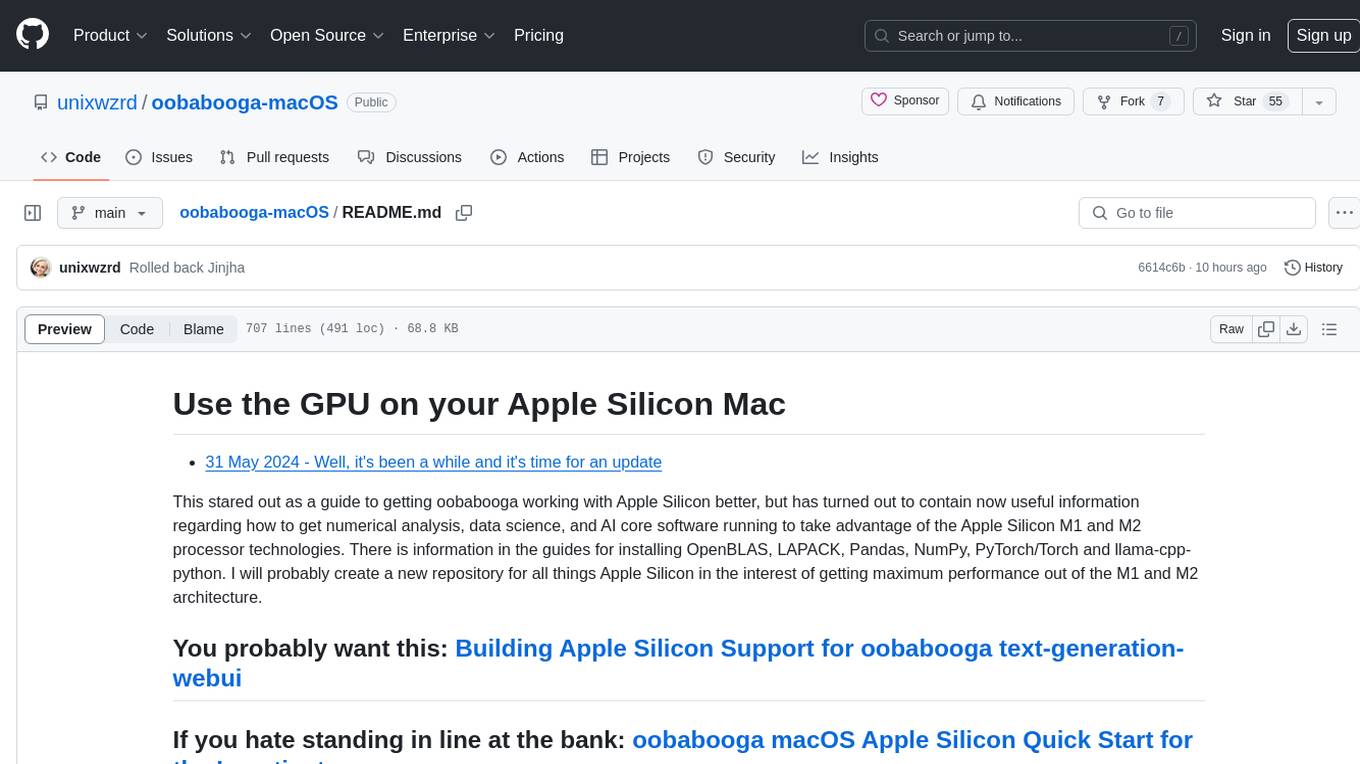
femtoGPT
Pure Rust implementation of a minimal Generative Pretrained Transformer
Stars: 758
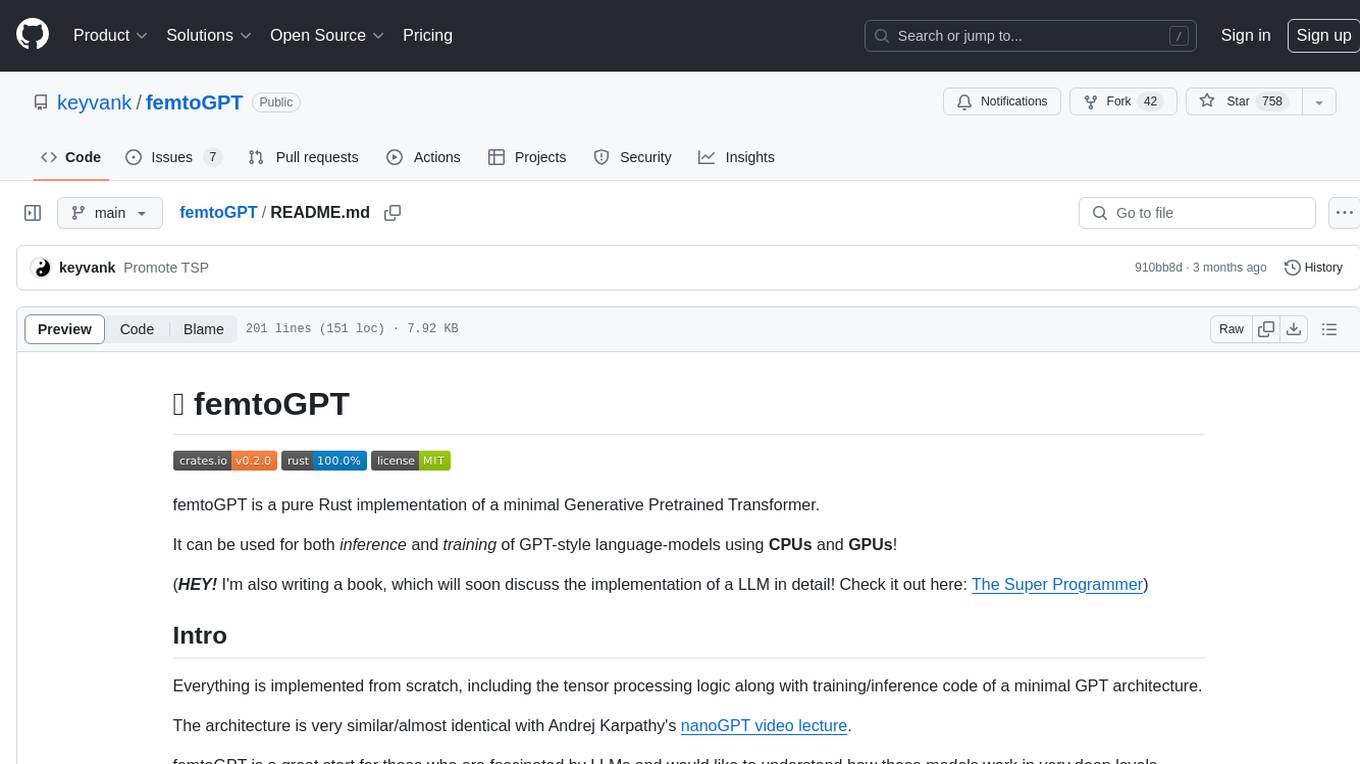
femtoGPT is a pure Rust implementation of a minimal Generative Pretrained Transformer. It can be used for both inference and training of GPT-style language models using CPUs and GPUs. The tool is implemented from scratch, including tensor processing logic and training/inference code of a minimal GPT architecture. It is a great start for those fascinated by LLMs and wanting to understand how these models work at deep levels. The tool uses random generation libraries, data-serialization libraries, and a parallel computing library. It is relatively fast on CPU and correctness of gradients is checked using the gradient-check method.
README:
femtoGPT is a pure Rust implementation of a minimal Generative Pretrained Transformer.
It can be used for both inference and training of GPT-style language-models using CPUs and GPUs!
(HEY! I'm also writing a book, which will soon discuss the implementation of a LLM in detail! Check it out here: The Super Programmer)
Everything is implemented from scratch, including the tensor processing logic along with training/inference code of a minimal GPT architecture.
The architecture is very similar/almost identical with Andrej Karpathy's nanoGPT video lecture.
femtoGPT is a great start for those who are fascinated by LLMs and would like to understand how these models work in very deep levels.
femtoGPT uses nothing but random generation libraries (rand/rand-distr), data-serialization
libraries (serde/bincode for saving/loading already trained models) and a
parallel computing library (rayon).
femtoGPT is EXTREMELY SLOW relatively fast on CPU 😉, and most of the
primitive operations (E.g Matrix multiplication) are implemented in the simplest way possible.
Correctness of gradients is checked using gradient-check method, though it still is very possible that some layers are implemented wrongly.
(Discord server for discussions around the project!)
Make sure you have the Rust toolchain on your system, in order to compile and run the project:
curl --proto '=https' --tlsv1.2 -sSf https://sh.rustup.rs | sh
If you want to train using a GPU, you will first need to make sure your GPU drivers are correctly installed on your system, and their OpenCL runtimes are available.
On Debian systems, you can setup OpenCL runtimes by installing the package ocl-icd-opencl-dev:
sudo apt install ocl-icd-opencl-dev
GOOD NEWS! Since femtoGPT's GPU implementation is based on OpenCL, it can run on both NVIDIA and AMD cards, and you won't need to install heavy-weight CUDA-toolkits on your system. OpenCL runtimes would suffice!
Now you'll just need to put the text you want to train your GPT model on, inside
dataset.txt. Make sure it has a small number of unique characters! (E.g. the
current dataset has only used 65 different unique characters!)
Then you'll need to run:
cargo run --release
It will start training the model and will put the training data in the train_data
directory. You can stop the training and continue later!
After hours of training on the Shakespeare database, on a 300k parameter model, this has been the output:
LIS:
Tore hend shater sorerds tougeng an herdofed seng he borind,
Ound ourere sthe, a sou so tousthe ashtherd, m se a man stousshan here hat mend serthe fo witownderstesther s ars at atheno sel theas,
thisth t are sorind bour win soutinds mater horengher
This is embarrassingly bad, but looking at the bright side, it seems like it has been able to generate words that are easy to pronounce.
I'm currently training a 10M parameter model to further examine the correctness of my implementation.
UPDATE 5th June 2023:
This has been a new output, after more hours of training on a model with similar scale:
What like but wore pad wo me che nogns yous dares,
As supt it nind bupart 'the reed:
And hils not es
Obviously the model has started to learn some words and punctuation rules!
UPDATE 9th June 2023:
Model was able to reach loss value of ~1.4
Here is an example output:
Adistition gone; true; schistoes for mine souls!
Before your home, bariechts should be
Carlam on that's a worf quirer of him so.
What look'd lack away more
To him foot; one hour fortious of saves:
Son;
'Tis all Earl mmistling me.
HARSARTIO:
Why, idless of my mocks fan that were percious.
Having I will thou should and the muour ne'er shor
To purple, when duke thy are out him.
But will bid you doth remember nature.
Even OF hencomey, carniffeit, I joy
Warming; my deed, but it on of mortard,
UPDATE 10th June 2023, sparks of AGI? LOL
Having trained a 5-layer model on a dataset gathered from Reddit, tokenized with sentencepiece tokenizer with a vocab-size of 500, for about ~10 hours on a 32-core CPU:
Prompt "I think":
I think it s not a scientific method of atheism
I think it s not a fairly simple possible to have a
I think that s a possible point, but I m not sure if you re not
I think that s a great idea, but I m not sure how these are you talking
I think it s a simple thing to do, but I m not sure how thes
I think that s a good thing, but I don t think that s what I mean, I think I
I think that s the only way to be able to use it to be in the same way, but
I think that the police are relatively relatively relative
I think that s a simple moron is a simple character
I think that s the only way to go to the second side of the pol
Prompt "Life is":
Life is not a good idea, but it s not a perfection of the opp
Life is a good thing to say that I don t know what you re talking about, but I don
Life is not the same as a religion, but I m not sure if you re a
Life is a perfectly good job of arguing that you are alm
Life is a perfectly good job of the opposite of the f
Life is a fundamentalist, and then I m not sure how the h
Life is not a good idea, and it s not a perfectly good job, but I
Life is not the same as atheists, but that s the only way to be ac
Life is a bit of a single one of these industry is a f
Life is a good idea to get the opposite of the police offic
Prompt "So sad that":
So sad that you can tell you what? I think I ve been using it on the scre
So sad that I don t know about it, but I don t think I m not afraid to
So sad that I m not sure if you re not arguing with the fact that you
So sad that I was involved in the future, and I have a few we
So sad that s what I said, I m sure you are almost everything you
So sad that you can do it, and I don t think that the fact that it s a po
So sad that I m not sure if you re arguing with the fact that they are
So sad that s the one too much time, but I m not sure if you re arg
So sad that you are sadly supposed to be a big deal in the world
So sad that I don t know about this, but I m not sure how you can do it, but
UPDATE 29th June 2023
After the implementation of the GPU trainer, we were able to train larger models. Here are some samples from a 8-layer 8-head 128-embedding-degree model, trained on TinyStories dataset on a vocab-size of 1000:
Once upon a time, there was a little girl named Lily.
She loved to play with her toys and she had a lot of fun.
One day, Lily saw a big chicky playing with her toys.
She asked her mom, "Can I play with her toys?" Her mom said,
"Sure, Lily. But we have to clean the pales. Let's suet some candy, Lily."
Lily nodded and went to her mom. They played with the mots and staugning her toys.
Once upon a time, there was a little girl named Lily.
She loved to play outside and explore. One day, she found a jung on the ground.
She picked it up and tecked it. She ran around and saw it. She was very sad.
She asked her mom for her mom. Her mom said, "Lily, I'm going to find it!" Lily said.
She ran to the slock and took her to the teplace. She went to the park and found a molla.
There was a boy named Tim. Tim loved to play with his toys.
One day, Tim's mom came to the park. Tim saw a big, red ball and wanted to play with it.
Tim wanted to play with the ball. Tim was very excited. He wanted to play with the ball.
But the ball was too fast. Tim wanted to play with the ball. But the ball was too fast.
Tim tried to catch it, but it was too fast. Tim was sad. He tried to run away,
but he did not want to play. Tim was sad. He did not want to play with the ball.
For Tasks:
Click tags to check more tools for each tasksFor Jobs:
Alternative AI tools for femtoGPT
Similar Open Source Tools

femtoGPT
femtoGPT is a pure Rust implementation of a minimal Generative Pretrained Transformer. It can be used for both inference and training of GPT-style language models using CPUs and GPUs. The tool is implemented from scratch, including tensor processing logic and training/inference code of a minimal GPT architecture. It is a great start for those fascinated by LLMs and wanting to understand how these models work at deep levels. The tool uses random generation libraries, data-serialization libraries, and a parallel computing library. It is relatively fast on CPU and correctness of gradients is checked using the gradient-check method.
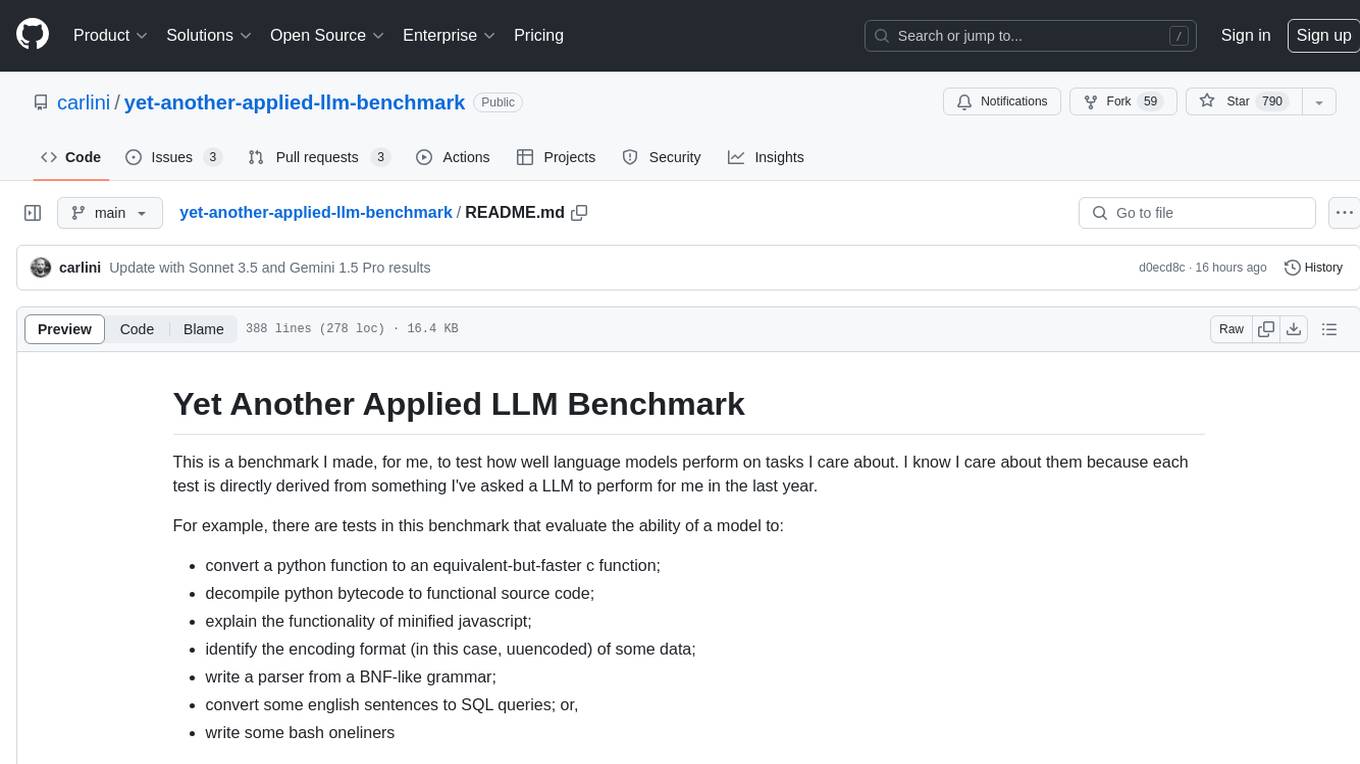
yet-another-applied-llm-benchmark
Yet Another Applied LLM Benchmark is a collection of diverse tests designed to evaluate the capabilities of language models in performing real-world tasks. The benchmark includes tests such as converting code, decompiling bytecode, explaining minified JavaScript, identifying encoding formats, writing parsers, and generating SQL queries. It features a dataflow domain-specific language for easily adding new tests and has nearly 100 tests based on actual scenarios encountered when working with language models. The benchmark aims to assess whether models can effectively handle tasks that users genuinely care about.
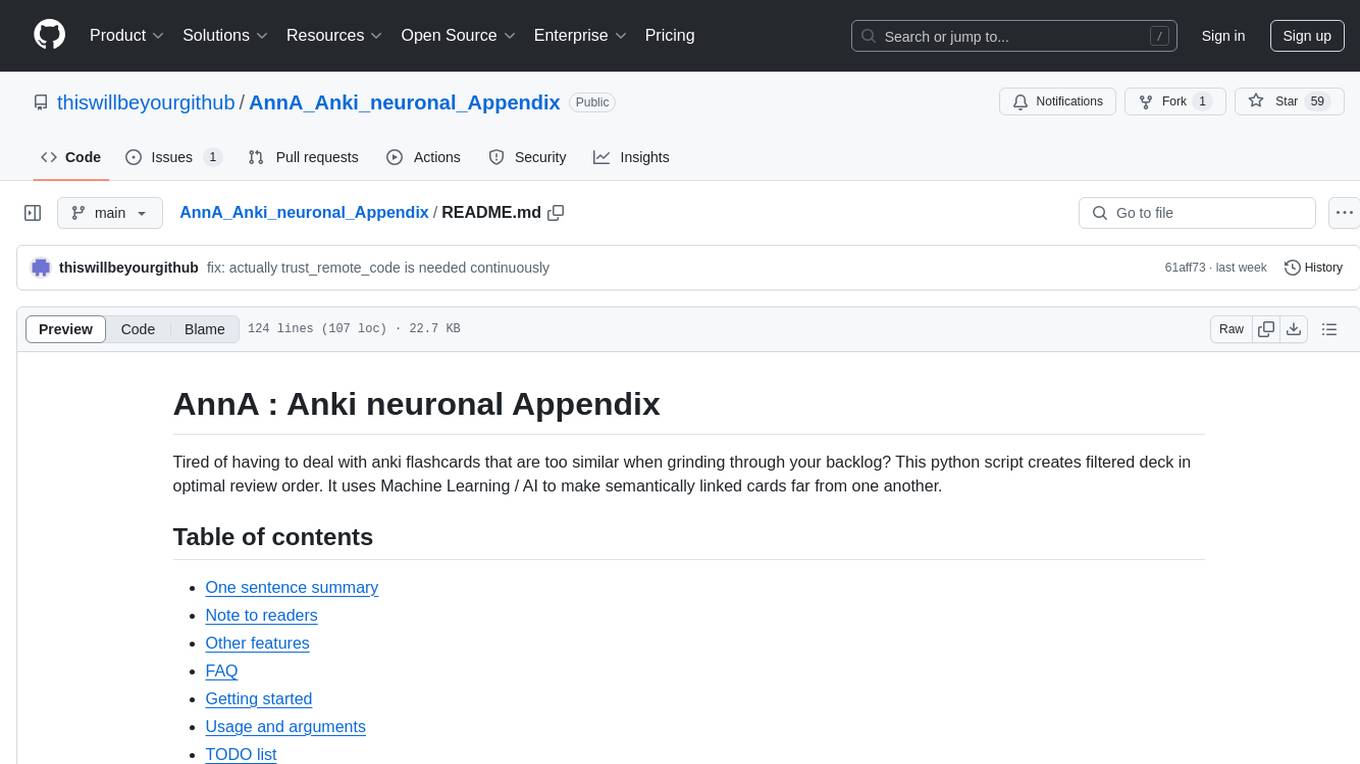
AnnA_Anki_neuronal_Appendix
AnnA is a Python script designed to create filtered decks in optimal review order for Anki flashcards. It uses Machine Learning / AI to ensure semantically linked cards are reviewed far apart. The script helps users manage their daily reviews by creating special filtered decks that prioritize reviewing cards that are most different from the rest. It also allows users to reduce the number of daily reviews while increasing retention and automatically identifies semantic neighbors for each note.
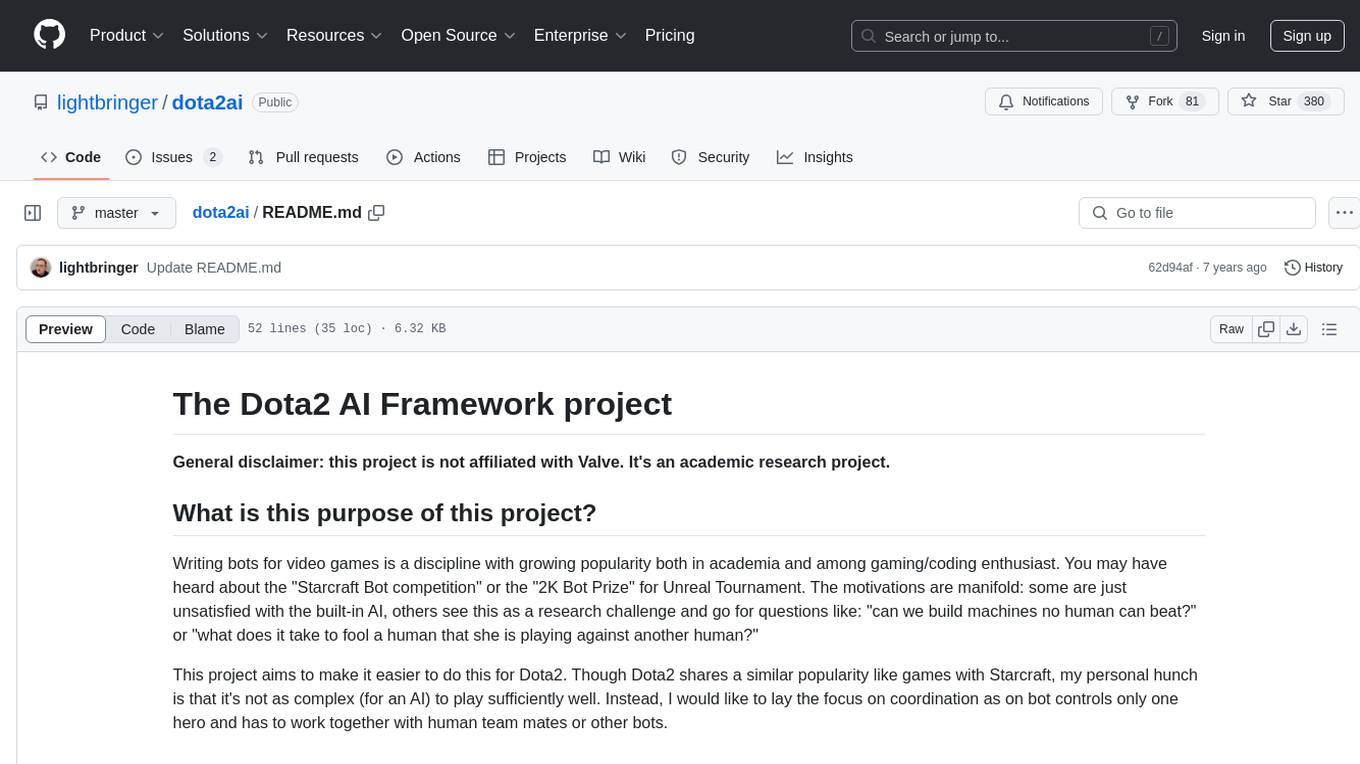
dota2ai
The Dota2 AI Framework project aims to provide a framework for creating AI bots for Dota2, focusing on coordination and teamwork. It offers a LUA sandbox for scripting, allowing developers to code bots that can compete in standard matches. The project acts as a proxy between the game and a web service through JSON objects, enabling bots to perform actions like moving, attacking, casting spells, and buying items. It encourages contributions and aims to enhance the AI capabilities in Dota2 modding.
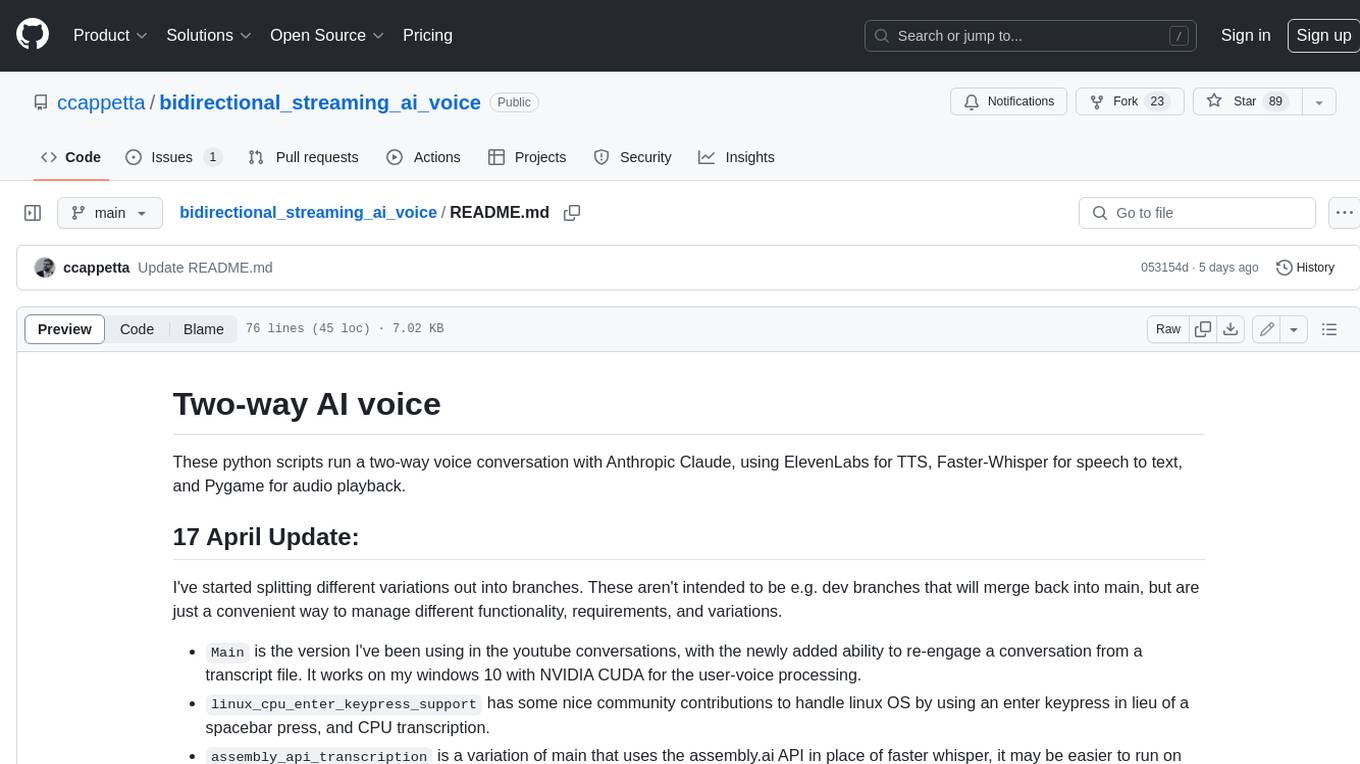
bidirectional_streaming_ai_voice
This repository contains Python scripts that enable two-way voice conversations with Anthropic Claude, utilizing ElevenLabs for text-to-speech, Faster-Whisper for speech-to-text, and Pygame for audio playback. The tool operates by transcribing human audio using Faster-Whisper, sending the transcription to Anthropic Claude for response generation, and converting the LLM's response into audio using ElevenLabs. The audio is then played back through Pygame, allowing for a seamless and interactive conversation between the user and the AI. The repository includes variations of the main script to support different operating systems and configurations, such as using CPU transcription on Linux or employing the AssemblyAI API instead of Faster-Whisper.
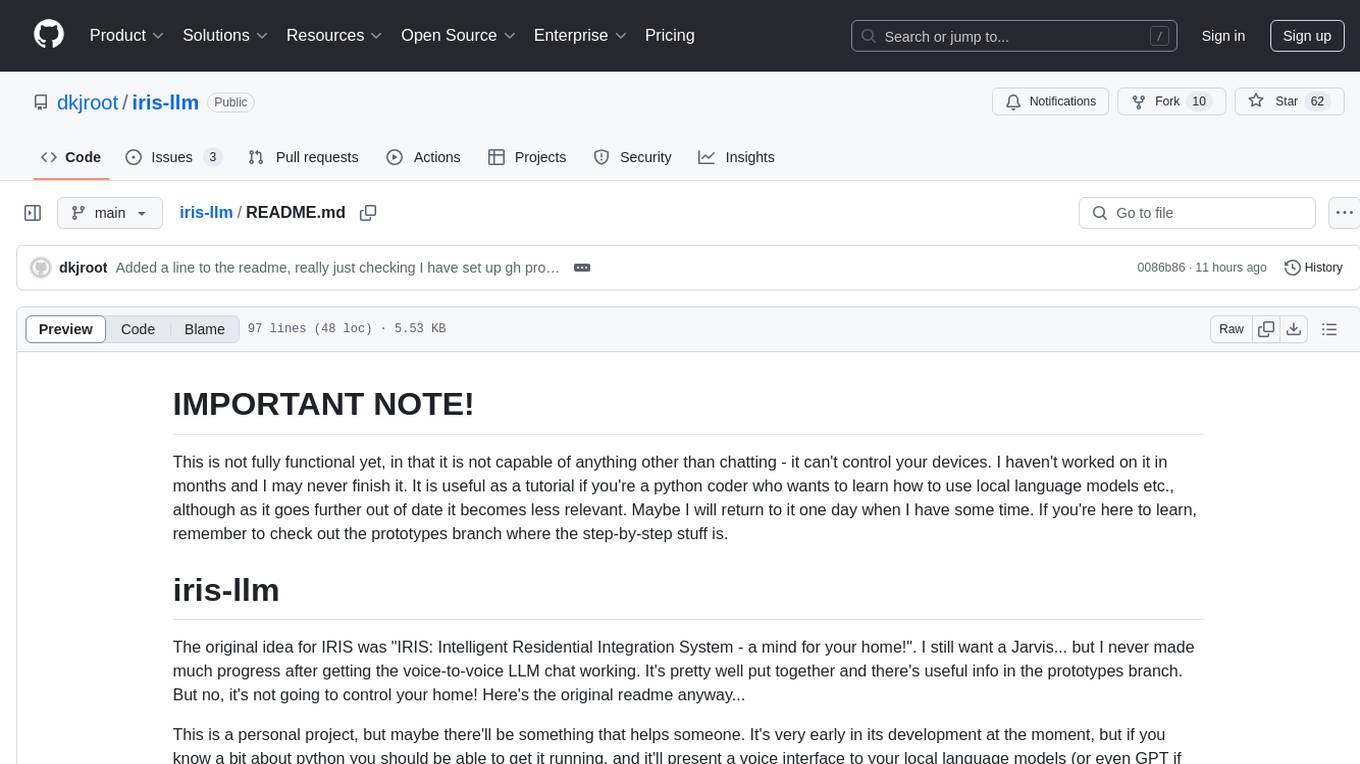
iris-llm
iris-llm is a personal project aimed at creating an Intelligent Residential Integration System (IRIS) with a voice interface to local language models or GPT. It provides options for chat engines, text-to-speech engines, speech-to-text engines, feedback sounds, and push-to-talk or wake word features. The tool is still in early development and serves as a tutorial for Python coders interested in working with language models.
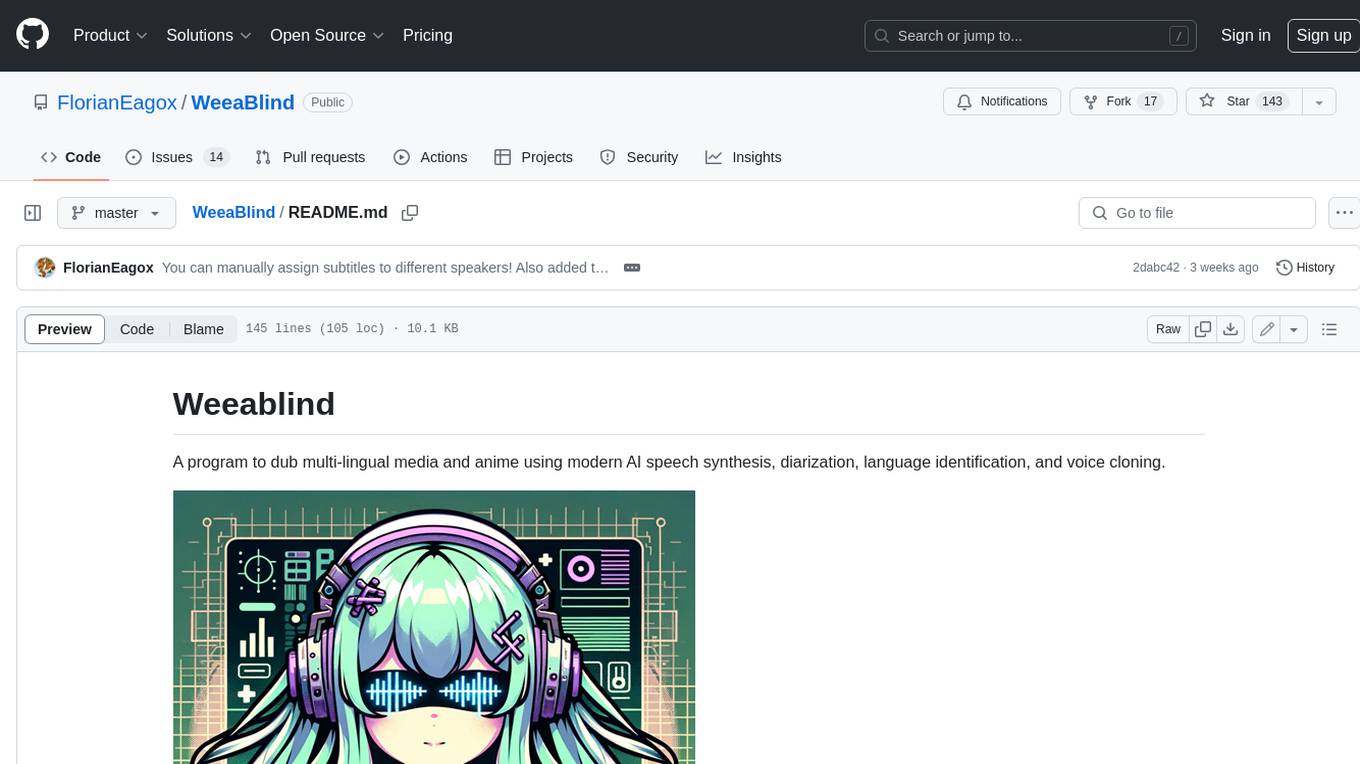
WeeaBlind
Weeablind is a program that uses modern AI speech synthesis, diarization, language identification, and voice cloning to dub multi-lingual media and anime. It aims to create a pleasant alternative for folks facing accessibility hurdles such as blindness, dyslexia, learning disabilities, or simply those that don't enjoy reading subtitles. The program relies on state-of-the-art technologies such as ffmpeg, pydub, Coqui TTS, speechbrain, and pyannote.audio to analyze and synthesize speech that stays in-line with the source video file. Users have the option of dubbing every subtitle in the video, setting the start and end times, dubbing only foreign-language content, or full-blown multi-speaker dubbing with speaking rate and volume matching.
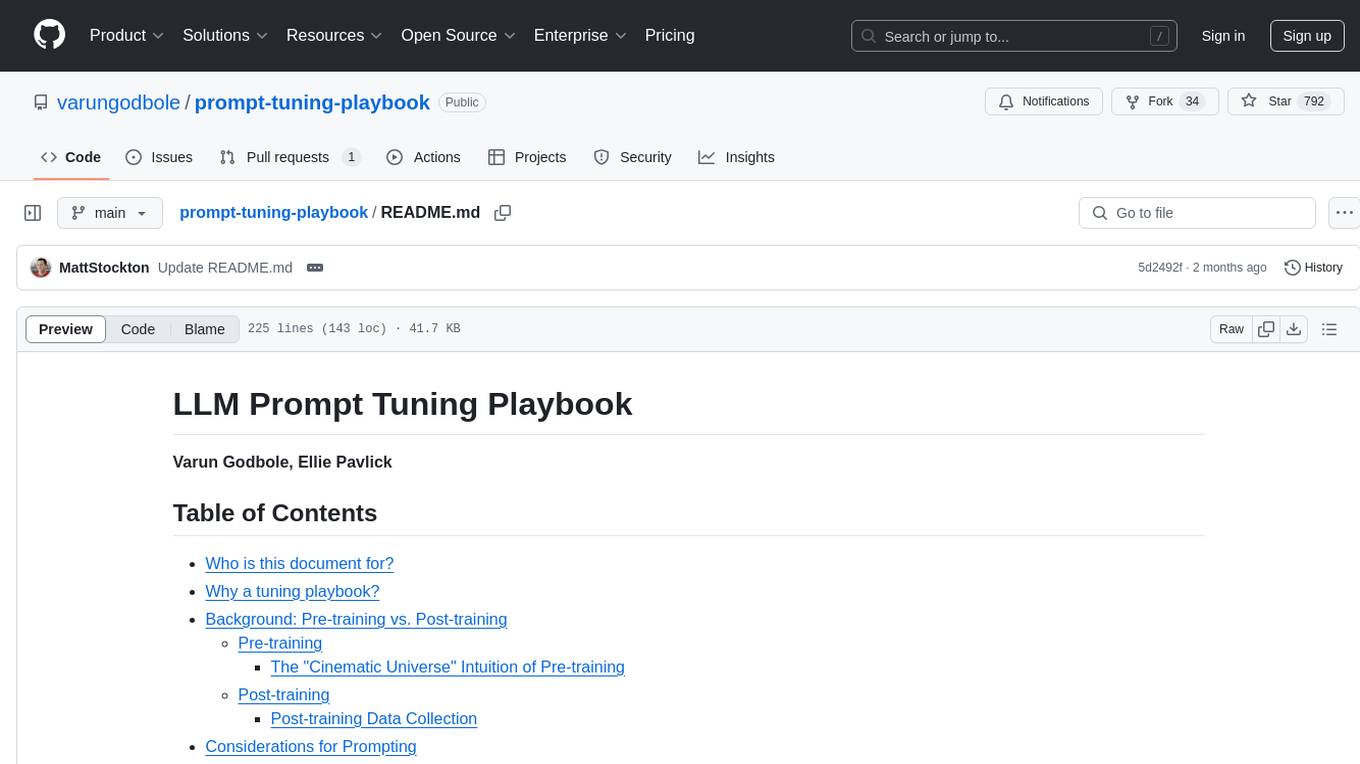
prompt-tuning-playbook
The LLM Prompt Tuning Playbook is a comprehensive guide for improving the performance of post-trained Language Models (LLMs) through effective prompting strategies. It covers topics such as pre-training vs. post-training, considerations for prompting, a rudimentary style guide for prompts, and a procedure for iterating on new system instructions. The playbook emphasizes the importance of clear, concise, and explicit instructions to guide LLMs in generating desired outputs. It also highlights the iterative nature of prompt development and the need for systematic evaluation of model responses.
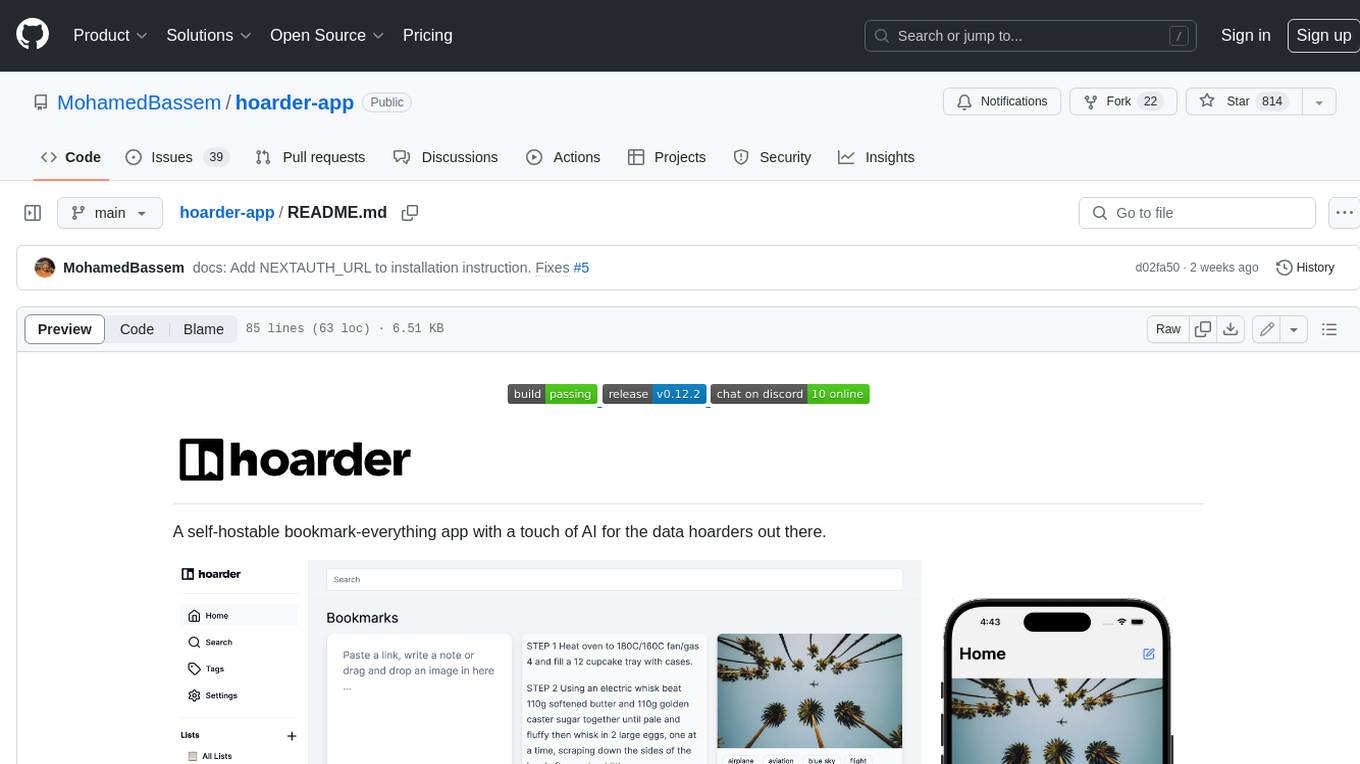
hoarder-app
Hoarder is a self-hostable bookmark manager with a focus on privacy and customization. It features automatic link previews, full-text search, AI-based tagging, and a variety of import and export options. Hoarder is designed to be easy to use and extensible, with a plugin system that allows users to add their own features and integrations.
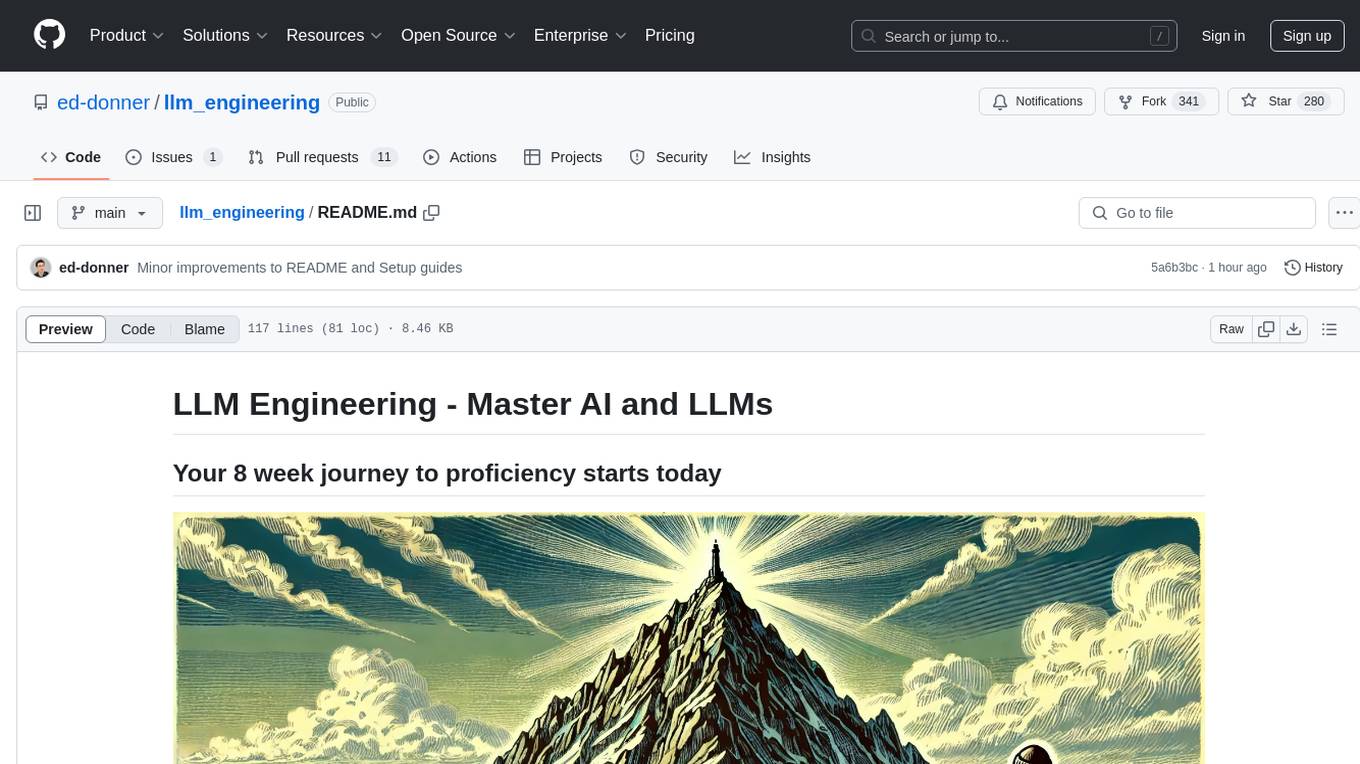
llm_engineering
LLM Engineering is an 8-week course designed to help learners master AI and LLMs through a series of projects that gradually increase in complexity. The course covers setting up the environment, working with APIs, using Google Colab for GPU processing, and building an autonomous Agentic AI solution. Learners are encouraged to actively participate, run code cells, tweak code, and share their progress with the community. The emphasis is on practical, educational projects that teach valuable business skills.
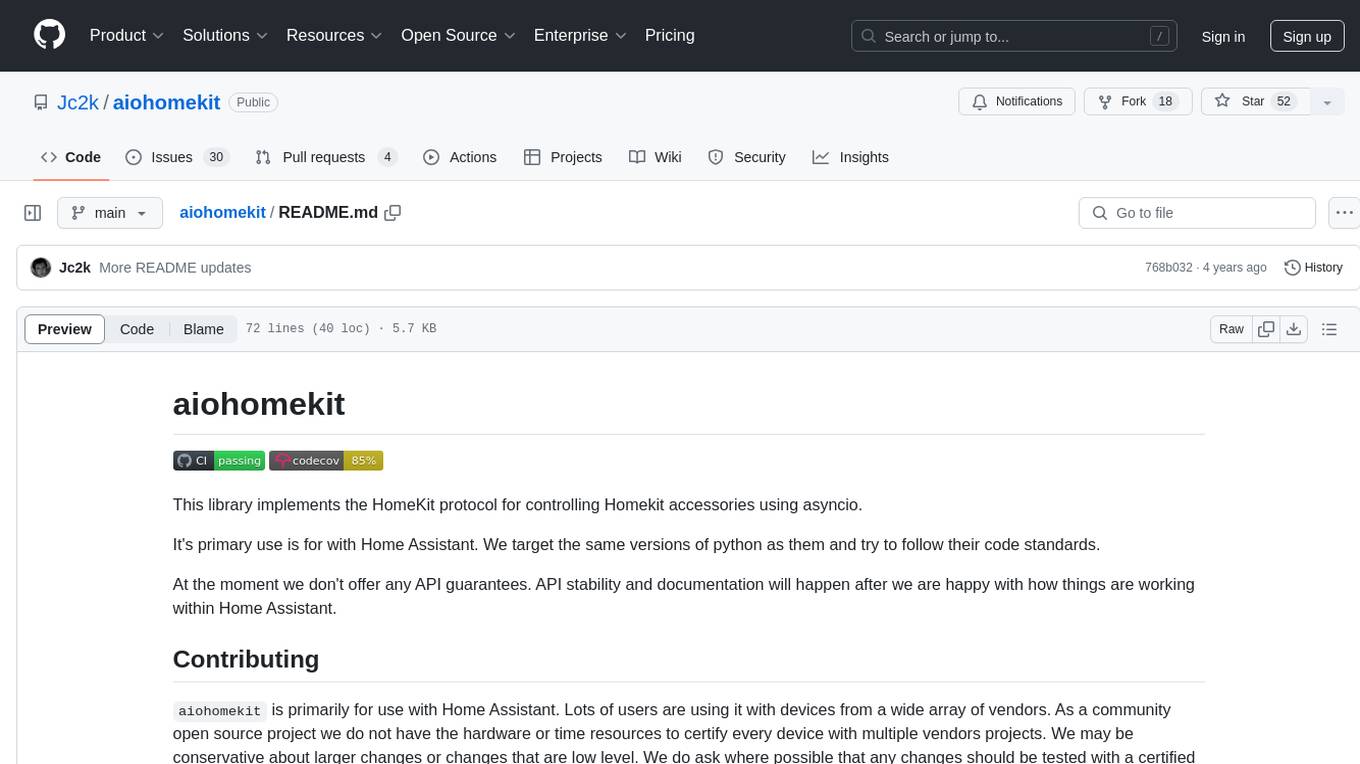
aiohomekit
aiohomekit is a Python library that implements the HomeKit protocol for controlling HomeKit accessories using asyncio. It is primarily used with Home Assistant, targeting the same versions of Python and following their code standards. The library is still under development and does not offer API guarantees yet. It aims to match the behavior of real HAP controllers, even when not strictly specified, and works around issues like JSON formatting, boolean encoding, header sensitivity, and TCP packet splitting. aiohomekit is primarily tested with Phillips Hue and Eve Extend bridges via Home Assistant, but is known to work with many more devices. It does not support BLE accessories and is intended for client-side use only.
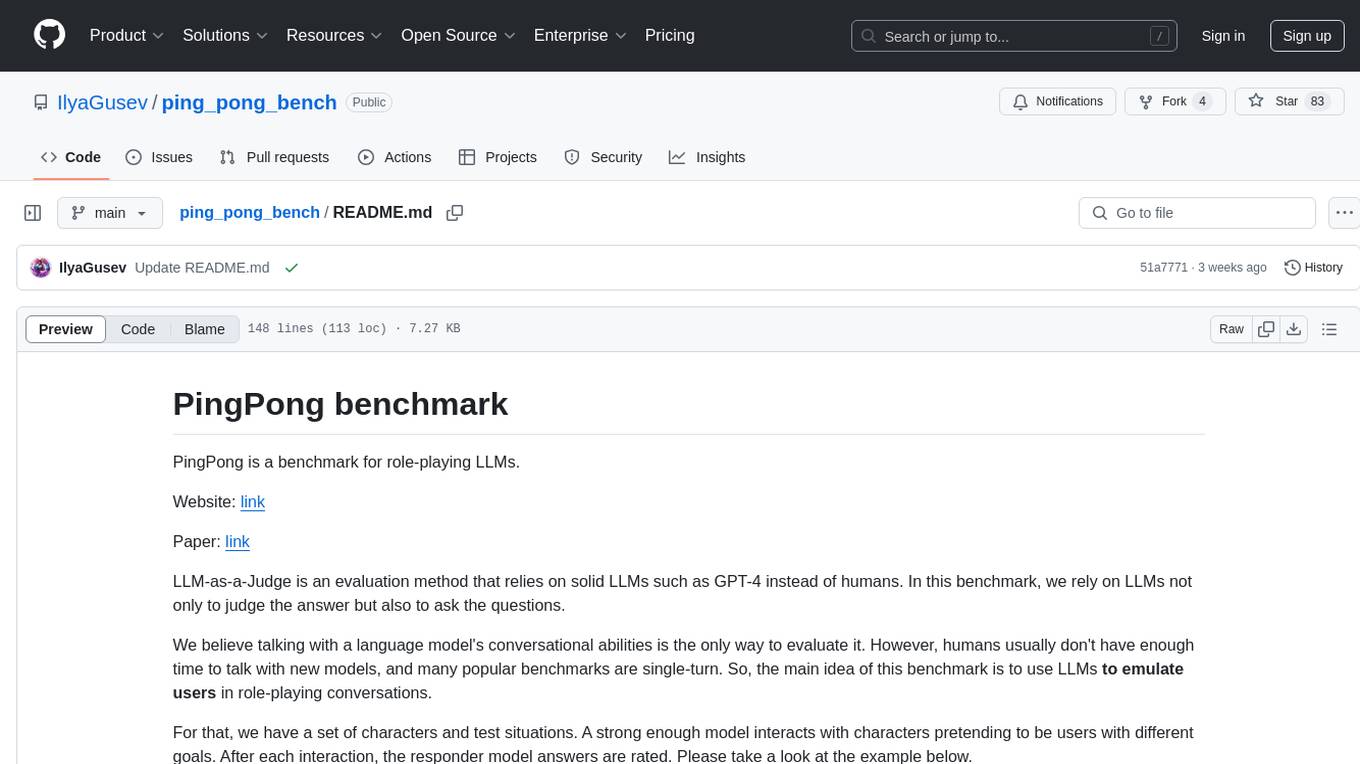
ping_pong_bench
PingPong is a benchmark designed for role-playing language models, focusing on evaluating conversational abilities through interactions with characters and test situations. The benchmark uses LLMs to emulate users in role-playing conversations, assessing criteria such as character portrayal, entertainment value, and fluency. Users can engage in dialogues with specific characters, like Kurisu, and evaluate the bot's responses based on predefined criteria. PingPong aims to provide a comprehensive evaluation method for language models, moving beyond single-turn interactions to more complex conversational scenarios.

local-chat
LocalChat is a simple, easy-to-set-up, and open-source local AI chat tool that allows users to interact with generative language models on their own computers without transmitting data to a cloud server. It provides a chat-like interface for users to experience ChatGPT-like behavior locally, ensuring GDPR compliance and data privacy. Users can download LocalChat for macOS, Windows, or Linux to chat with open-weight generative language models.
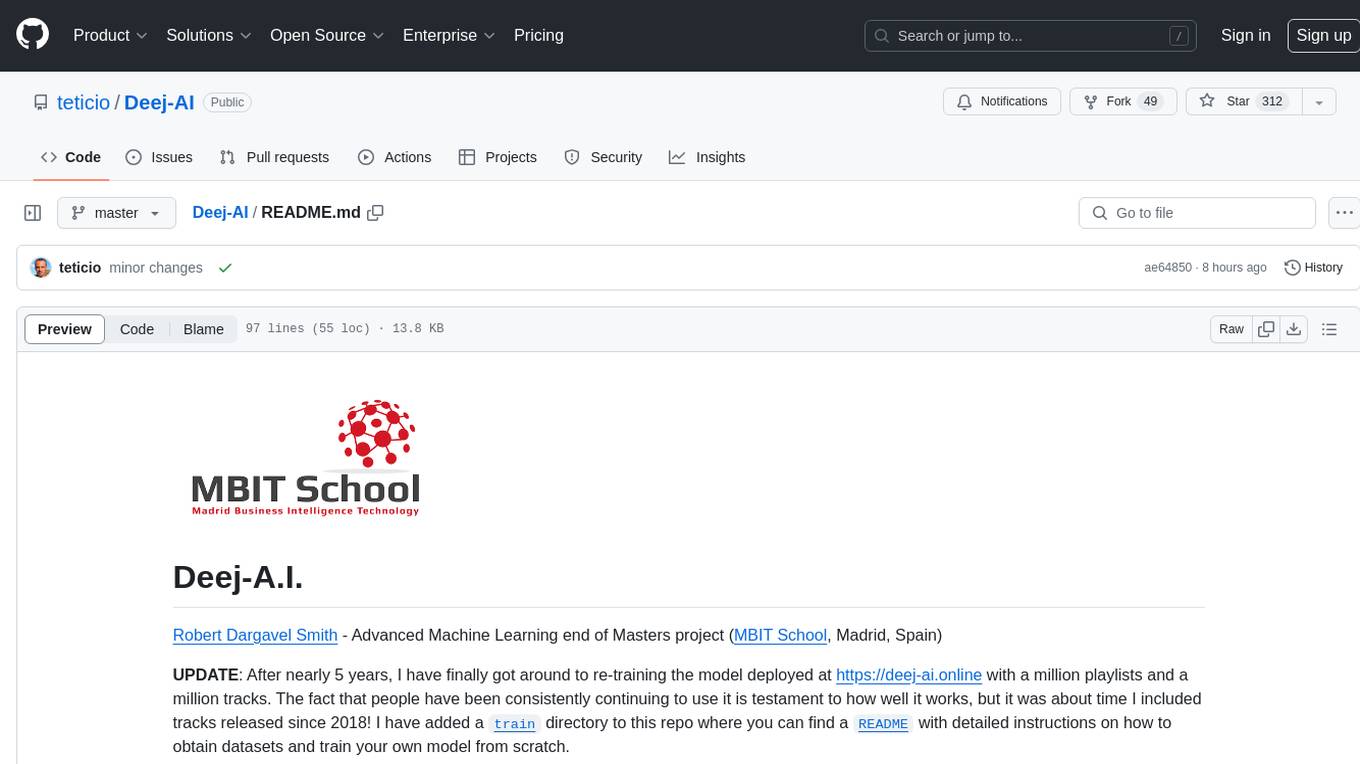
Deej-AI
Deej-A.I. is an advanced machine learning project that aims to revolutionize music recommendation systems by using artificial intelligence to analyze and recommend songs based on their content and characteristics. The project involves scraping playlists from Spotify, creating embeddings of songs, training neural networks to analyze spectrograms, and generating recommendations based on similarities in music features. Deej-A.I. offers a unique approach to music curation, focusing on the 'what' rather than the 'how' of DJing, and providing users with personalized and creative music suggestions.
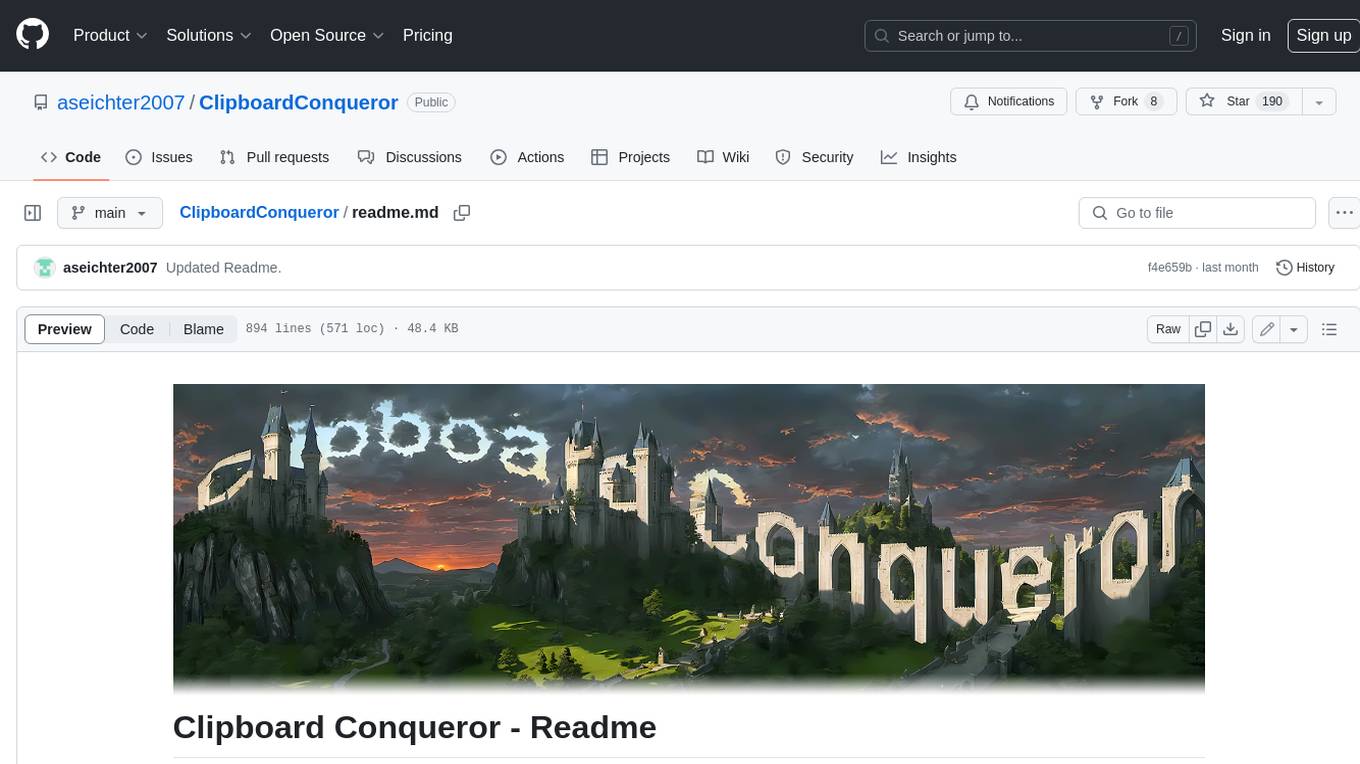
ClipboardConqueror
Clipboard Conqueror is a multi-platform omnipresent copilot alternative. Currently requiring a kobold united or openAI compatible back end, this software brings powerful LLM based tools to any text field, the universal copilot you deserve. It simply works anywhere. No need to sign in, no required key. Provided you are using local AI, CC is a data secure alternative integration provided you trust whatever backend you use. *Special thank you to the creators of KoboldAi, KoboldCPP, llamma, openAi, and the communities that made all this possible to figure out.
For similar tasks
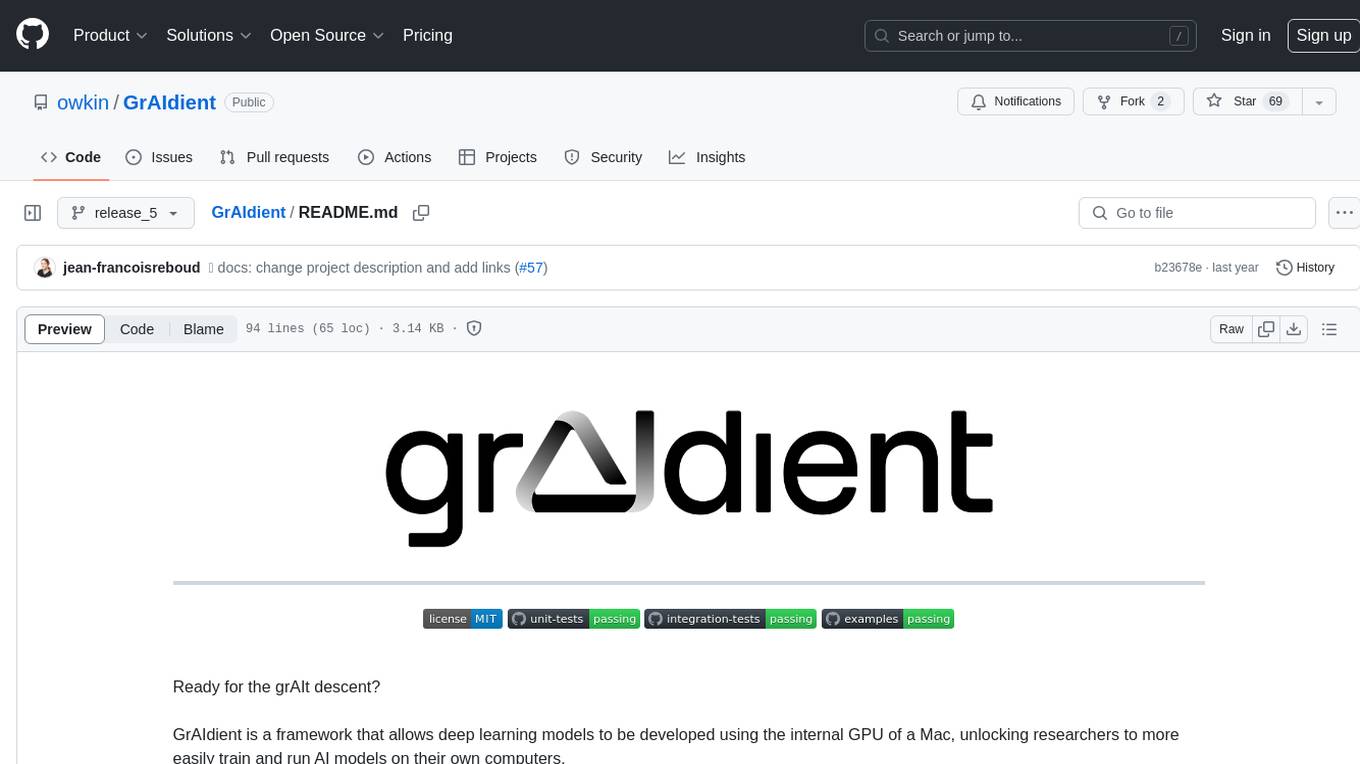
GrAIdient
GrAIdient is a framework designed to enable the development of deep learning models using the internal GPU of a Mac. It provides access to the graph of layers, allowing for unique model design with greater understanding, control, and reproducibility. The goal is to challenge the understanding of deep learning models, transitioning from black box to white box models. Key features include direct access to layers, native Mac GPU support, Swift language implementation, gradient checking, PyTorch interoperability, and more. The documentation covers main concepts, architecture, and examples. GrAIdient is MIT licensed.

femtoGPT
femtoGPT is a pure Rust implementation of a minimal Generative Pretrained Transformer. It can be used for both inference and training of GPT-style language models using CPUs and GPUs. The tool is implemented from scratch, including tensor processing logic and training/inference code of a minimal GPT architecture. It is a great start for those fascinated by LLMs and wanting to understand how these models work at deep levels. The tool uses random generation libraries, data-serialization libraries, and a parallel computing library. It is relatively fast on CPU and correctness of gradients is checked using the gradient-check method.

LLMStack
LLMStack is a no-code platform for building generative AI agents, workflows, and chatbots. It allows users to connect their own data, internal tools, and GPT-powered models without any coding experience. LLMStack can be deployed to the cloud or on-premise and can be accessed via HTTP API or triggered from Slack or Discord.
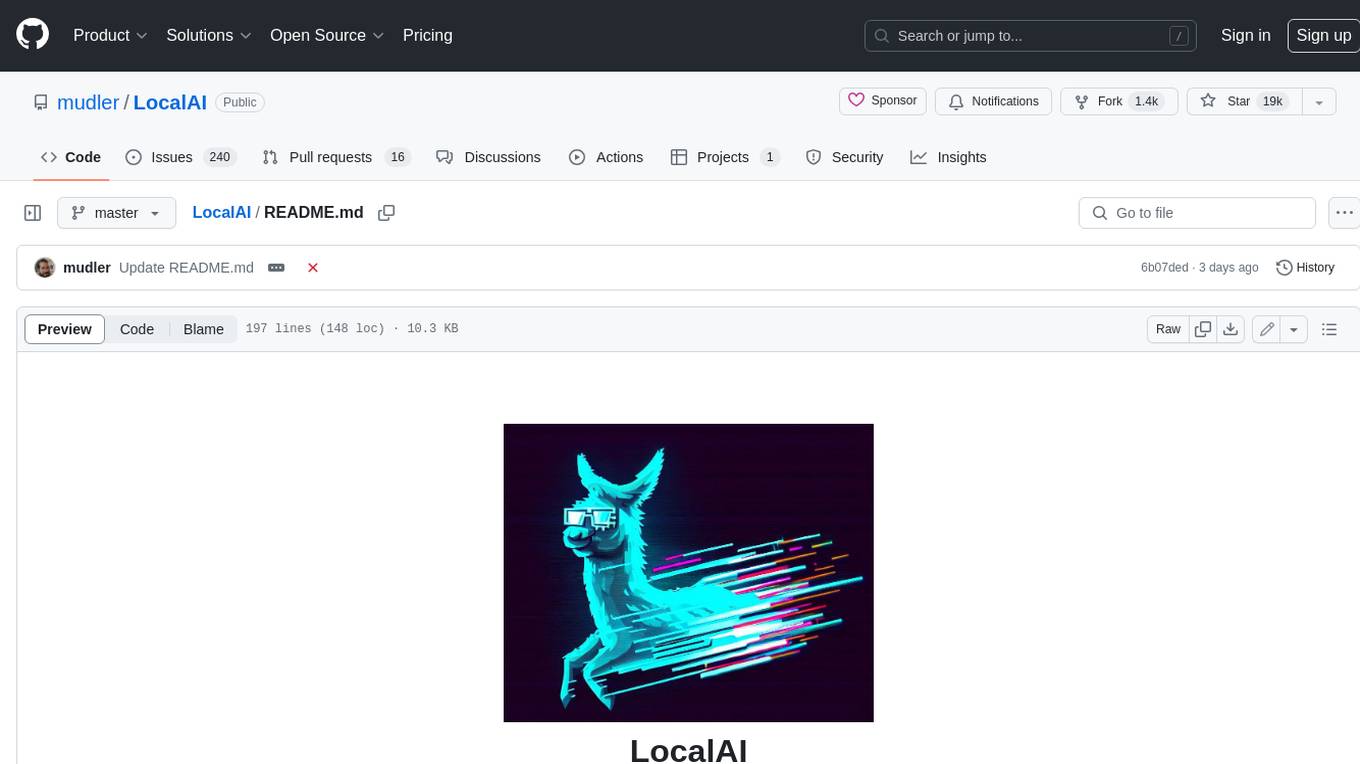
LocalAI
LocalAI is a free and open-source OpenAI alternative that acts as a drop-in replacement REST API compatible with OpenAI (Elevenlabs, Anthropic, etc.) API specifications for local AI inferencing. It allows users to run LLMs, generate images, audio, and more locally or on-premises with consumer-grade hardware, supporting multiple model families and not requiring a GPU. LocalAI offers features such as text generation with GPTs, text-to-audio, audio-to-text transcription, image generation with stable diffusion, OpenAI functions, embeddings generation for vector databases, constrained grammars, downloading models directly from Huggingface, and a Vision API. It provides a detailed step-by-step introduction in its Getting Started guide and supports community integrations such as custom containers, WebUIs, model galleries, and various bots for Discord, Slack, and Telegram. LocalAI also offers resources like an LLM fine-tuning guide, instructions for local building and Kubernetes installation, projects integrating LocalAI, and a how-tos section curated by the community. It encourages users to cite the repository when utilizing it in downstream projects and acknowledges the contributions of various software from the community.
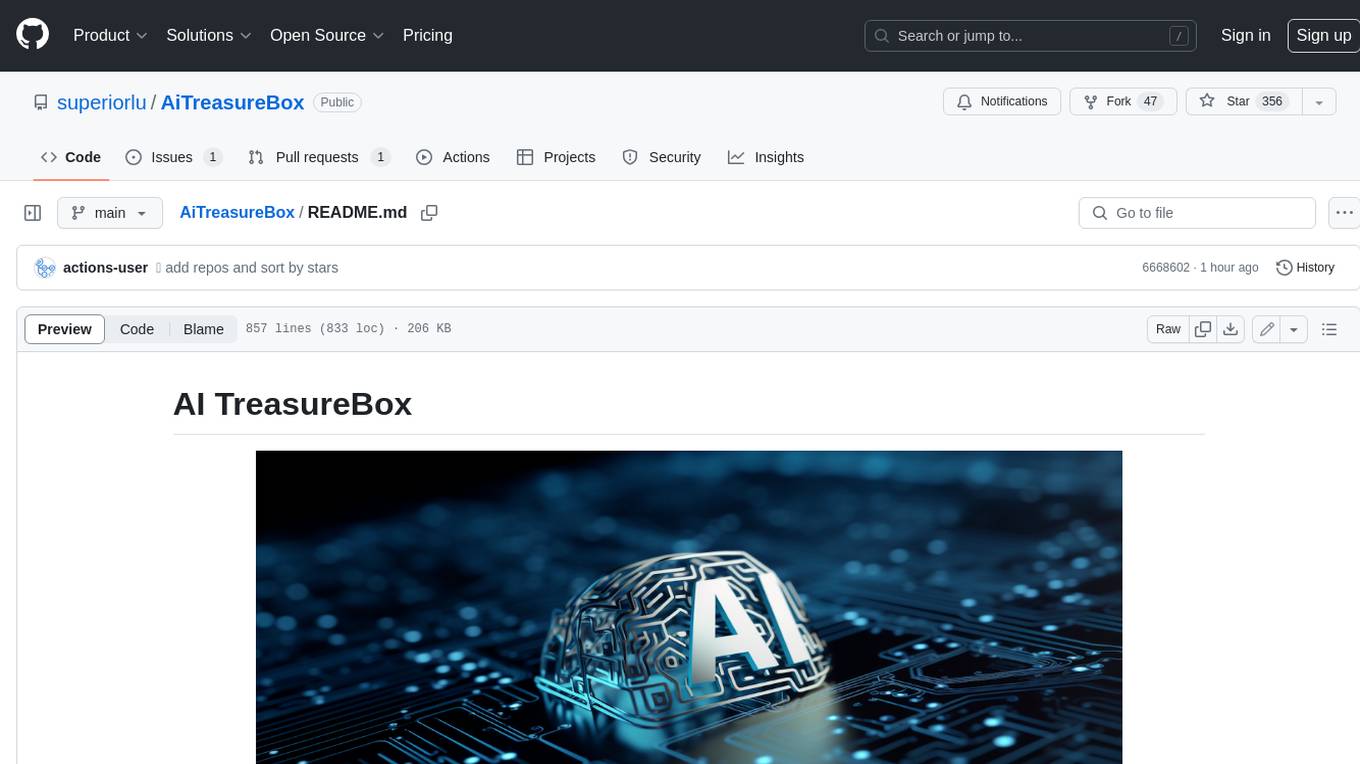
AiTreasureBox
AiTreasureBox is a versatile AI tool that provides a collection of pre-trained models and algorithms for various machine learning tasks. It simplifies the process of implementing AI solutions by offering ready-to-use components that can be easily integrated into projects. With AiTreasureBox, users can quickly prototype and deploy AI applications without the need for extensive knowledge in machine learning or deep learning. The tool covers a wide range of tasks such as image classification, text generation, sentiment analysis, object detection, and more. It is designed to be user-friendly and accessible to both beginners and experienced developers, making AI development more efficient and accessible to a wider audience.
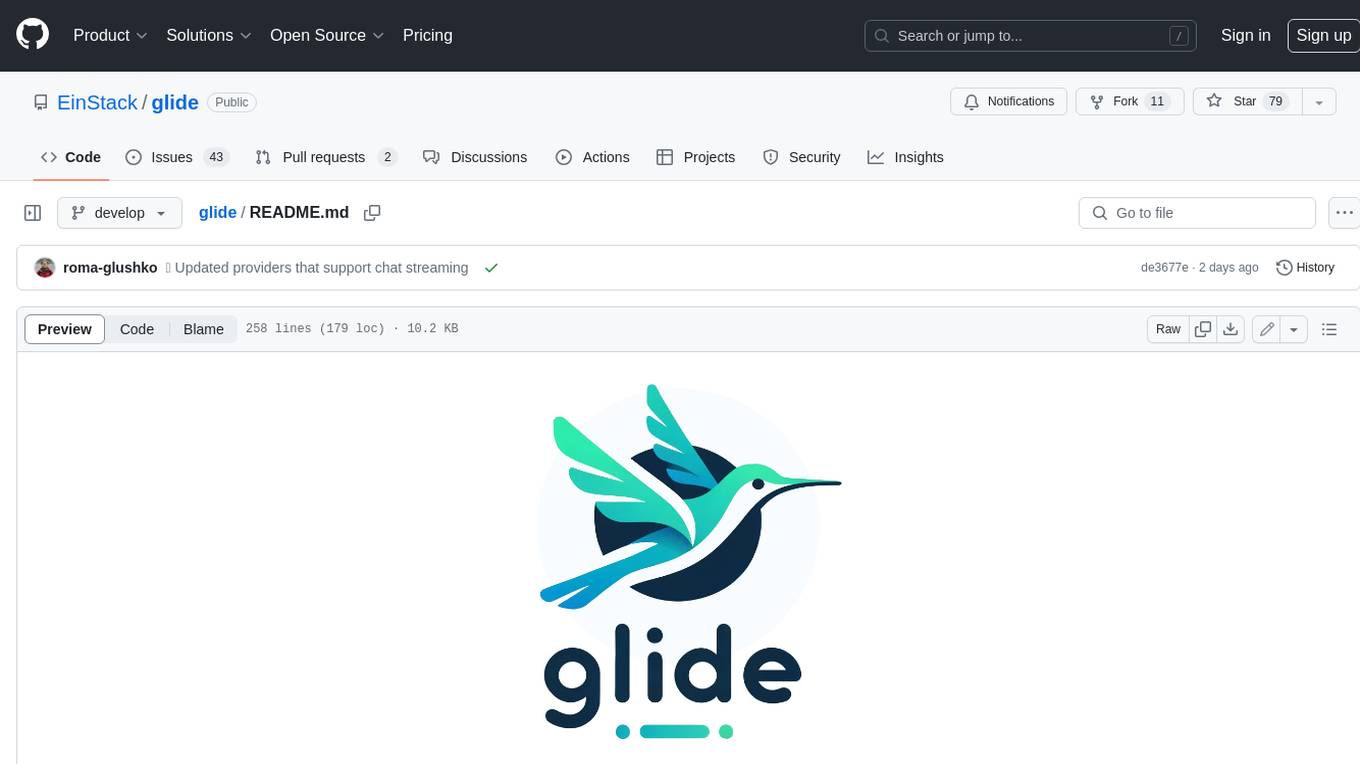
glide
Glide is a cloud-native LLM gateway that provides a unified REST API for accessing various large language models (LLMs) from different providers. It handles LLMOps tasks such as model failover, caching, key management, and more, making it easy to integrate LLMs into applications. Glide supports popular LLM providers like OpenAI, Anthropic, Azure OpenAI, AWS Bedrock (Titan), Cohere, Google Gemini, OctoML, and Ollama. It offers high availability, performance, and observability, and provides SDKs for Python and NodeJS to simplify integration.

jupyter-ai
Jupyter AI connects generative AI with Jupyter notebooks. It provides a user-friendly and powerful way to explore generative AI models in notebooks and improve your productivity in JupyterLab and the Jupyter Notebook. Specifically, Jupyter AI offers: * An `%%ai` magic that turns the Jupyter notebook into a reproducible generative AI playground. This works anywhere the IPython kernel runs (JupyterLab, Jupyter Notebook, Google Colab, Kaggle, VSCode, etc.). * A native chat UI in JupyterLab that enables you to work with generative AI as a conversational assistant. * Support for a wide range of generative model providers, including AI21, Anthropic, AWS, Cohere, Gemini, Hugging Face, NVIDIA, and OpenAI. * Local model support through GPT4All, enabling use of generative AI models on consumer grade machines with ease and privacy.

langchain_dart
LangChain.dart is a Dart port of the popular LangChain Python framework created by Harrison Chase. LangChain provides a set of ready-to-use components for working with language models and a standard interface for chaining them together to formulate more advanced use cases (e.g. chatbots, Q&A with RAG, agents, summarization, extraction, etc.). The components can be grouped into a few core modules: * **Model I/O:** LangChain offers a unified API for interacting with various LLM providers (e.g. OpenAI, Google, Mistral, Ollama, etc.), allowing developers to switch between them with ease. Additionally, it provides tools for managing model inputs (prompt templates and example selectors) and parsing the resulting model outputs (output parsers). * **Retrieval:** assists in loading user data (via document loaders), transforming it (with text splitters), extracting its meaning (using embedding models), storing (in vector stores) and retrieving it (through retrievers) so that it can be used to ground the model's responses (i.e. Retrieval-Augmented Generation or RAG). * **Agents:** "bots" that leverage LLMs to make informed decisions about which available tools (such as web search, calculators, database lookup, etc.) to use to accomplish the designated task. The different components can be composed together using the LangChain Expression Language (LCEL).
For similar jobs

weave
Weave is a toolkit for developing Generative AI applications, built by Weights & Biases. With Weave, you can log and debug language model inputs, outputs, and traces; build rigorous, apples-to-apples evaluations for language model use cases; and organize all the information generated across the LLM workflow, from experimentation to evaluations to production. Weave aims to bring rigor, best-practices, and composability to the inherently experimental process of developing Generative AI software, without introducing cognitive overhead.

LLMStack
LLMStack is a no-code platform for building generative AI agents, workflows, and chatbots. It allows users to connect their own data, internal tools, and GPT-powered models without any coding experience. LLMStack can be deployed to the cloud or on-premise and can be accessed via HTTP API or triggered from Slack or Discord.

VisionCraft
The VisionCraft API is a free API for using over 100 different AI models. From images to sound.

kaito
Kaito is an operator that automates the AI/ML inference model deployment in a Kubernetes cluster. It manages large model files using container images, avoids tuning deployment parameters to fit GPU hardware by providing preset configurations, auto-provisions GPU nodes based on model requirements, and hosts large model images in the public Microsoft Container Registry (MCR) if the license allows. Using Kaito, the workflow of onboarding large AI inference models in Kubernetes is largely simplified.

PyRIT
PyRIT is an open access automation framework designed to empower security professionals and ML engineers to red team foundation models and their applications. It automates AI Red Teaming tasks to allow operators to focus on more complicated and time-consuming tasks and can also identify security harms such as misuse (e.g., malware generation, jailbreaking), and privacy harms (e.g., identity theft). The goal is to allow researchers to have a baseline of how well their model and entire inference pipeline is doing against different harm categories and to be able to compare that baseline to future iterations of their model. This allows them to have empirical data on how well their model is doing today, and detect any degradation of performance based on future improvements.

tabby
Tabby is a self-hosted AI coding assistant, offering an open-source and on-premises alternative to GitHub Copilot. It boasts several key features: * Self-contained, with no need for a DBMS or cloud service. * OpenAPI interface, easy to integrate with existing infrastructure (e.g Cloud IDE). * Supports consumer-grade GPUs.

spear
SPEAR (Simulator for Photorealistic Embodied AI Research) is a powerful tool for training embodied agents. It features 300 unique virtual indoor environments with 2,566 unique rooms and 17,234 unique objects that can be manipulated individually. Each environment is designed by a professional artist and features detailed geometry, photorealistic materials, and a unique floor plan and object layout. SPEAR is implemented as Unreal Engine assets and provides an OpenAI Gym interface for interacting with the environments via Python.

Magick
Magick is a groundbreaking visual AIDE (Artificial Intelligence Development Environment) for no-code data pipelines and multimodal agents. Magick can connect to other services and comes with nodes and templates well-suited for intelligent agents, chatbots, complex reasoning systems and realistic characters.



